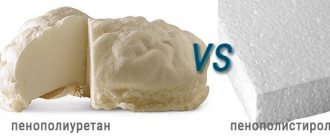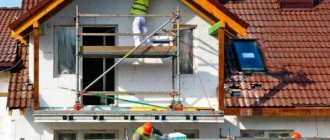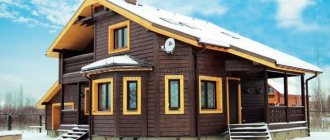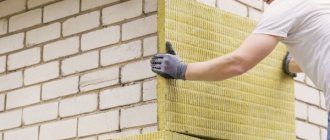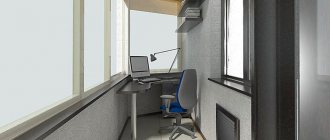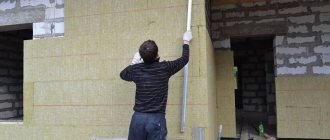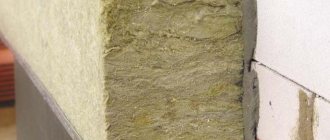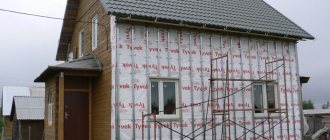The use of thermal insulation systems in building structures can significantly reduce heating costs. The use of all kinds of insulation makes it possible to speed up the pace of construction and reduce the budget for building a house. In order for them to cope with their responsibilities, you need to know how to choose them. Do you agree?
We will tell you how to choose the right insulation for the exterior walls of your home. The article we presented describes all types of thermal insulation materials used in practice and their operating features. Independent owners of country estates will find facade insulation technology here.
The difference between external insulation and internal insulation
If the insulation of a brick house is not carried out according to the rules, heat loss can reach up to 30% only through the walls. This factor can be influenced not only by the thickness of the partitions and the presence of cracks in it.
Insulation is also important. However, many people wonder: what is the best way to carry out insulation - outside or inside?
External insulation is the most acceptable option compared to internal insulation:
- The space from the inside will not be reduced due to the additional layer;
- There will be no additional load on the foundation and walls;
- Insulation can not only protect a building from winds and cold, but also serve as decoration for the facade;
- The walls will not freeze and accumulate moisture, whereas this may well happen with internal insulation. This happens because the dew point shifts. As a result, the service life of the building is reduced, and it is not always comfortable, causing trouble to the owners;
- The insulation also serves as a noise absorber from the outside.
Of course, there are a number of exceptions when it becomes impossible to install thermal insulation from the outside:
- The house is an architectural monument, therefore it is prohibited to disturb its façade;
- It is technically impossible to carry out façade work.
In this case, you can insulate the room from the inside, the main thing is to use materials that will be vapor permeable. Otherwise, the dew point will shift inward, causing the humidity to increase. And even subsequent insulation from the outside cannot solve this problem.
Material requirements
The best materials for insulation should have a number of properties:
- Shrinkage should be minimal, and there should be no deformation of the insulation due to sunlight or temperature changes. It must be resistant to various influences;
- Long service life;
- It is better to choose one that will not be attractive to rodents and insects;
- It is better if it is easy to install and does not require the purchase of special tools. If you can do the installation yourself without special skills and preparation, this will be the best option;
- It should also not be flammable;
- Don't forget about environmental friendliness;
- It must be vapor-permeable so that the indoor microclimate remains at the same level;
- The lower the ability to conduct air, the better. The room will retain heat longer. It should be noted that real conditions often do not coincide with laboratory conditions, so when purchasing, leave a reserve and remember that these indicators are conditional; in real-life operation they may not coincide;
Look at the density. The higher it is, the heavier the material. And this can put a significant load on the foundation and supporting structures, especially if the layer is thick.
Important characteristics when choosing thermal insulation
Insulation materials have many parameters that must be taken into account when choosing. Particularly important among them are:
- thermal conductivity - determines the ability of insulation to maintain indoor temperature;
- vapor permeability - the ability to transmit water vapor;
- material density - determines strength and affects thermal conductivity.
It is these characteristics that you need to pay the most attention to when choosing thermal insulation.
Assortment of insulation materials
For a certain type of structure, it is better to select appropriate materials. Thus, the insulation of a house under siding will be carried out using one type, and a wooden structure under another. What construction does not need this procedure is a frame house.
- There are also types that are only suitable for horizontal surfaces. And there are varieties that can be used on any type of wall.
- Now manufacturers care not only about technical characteristics, but also about versatility.
- Bulk material can not only be placed in cracks, but also mixed into cement to screed the floor or fill it.
- Mineral wool can be used on wet and suspended facades, and can also be used to insulate floors and walls.
- In addition, it is a heat-resistant material, so it can be used on appropriate buildings - baths or saunas, including in the house.
There are a lot of forms, so it’s easy to choose one that suits a specific area and structure. Bulk material can be used to insulate a basement, and large areas can be insulated with rolled material.
The better way to insulate brick walls (tables with indicators)
The choice of thermal insulation materials is made based on many criteria. But first of all, the thermal conductivity coefficient is considered. The table shows the final figures for bricks and insulators based on the calculation for central Russia.
| Material | Thermal conductivity (W/m*K) | Thickness (m) |
| Sand-lime solid brick | 0,76 | 2,38 |
| Smoked brick | 0,5 | 1,57 |
| Warm plaster | 0,065 | 0,21 |
| Mineral wool | 0,041 | 0,13 |
| Polyurethane foam | 0,035 | 0,12 |
| Extruded polystyrene foam | 0,028 | 0,12 |
Here the averaged data was taken into account. Manufacturers continue to develop new techniques and materials and improve existing ones. Therefore, on trading floors it is necessary to clarify the energy efficiency of each insulation.
Methods for insulating brick walls with various materials
Polystyrene foam and extruded polystyrene
One of the popular types, which is distinguished by low cost, durability and ease of installation. It does not absorb moisture and is lightweight, which is why many builders love it.
But it also has a number of disadvantages: it is accessible to rodents, it is flammable and can be destroyed under the influence of acetone.
Polystyrene foam can be presented both in the form of slabs and granules. Its structure is porous, so it is able to retain heat. It is inexpensive and lightweight, absorbs noise from the street.
- However, if you have a wooden house, then it is better to refuse to buy it. This material does not conduct moisture well, and for solid wood buildings this indicator is very important. Not only is it flammable, it can also release toxic gases when burned.
- Similar to regular foam, but it contains graphite. It is manufactured using more advanced technology, due to which its performance indicators are higher and the product itself is of better quality. Graphite gives additional strength and protection, so the structure is reliably protected from the penetration of cold.
- Quite durable, has low vapor permeability. You can insulate both walls and basements. Practically not subject to mechanical stress. Under favorable conditions, its service life can reach up to 30 years.
Its disadvantages are similar to conventional polystyrene foam. In addition, the cost of this type will be more expensive, because the manufacturing process is more complex and there are more components.
Work execution technologies
How to insulate a house from the outside? Two methods are used for this. Both can be used for almost any insulation material. The type of heat insulator has almost no effect on the technology. But you need to take into account certain recommendations from the manufacturer. For example, as is the case with mineral wool, when a ventilation gap is required.
There are two technologies:
- insulation of facades using the wet method;
- dry method, when a decorative coating is used, fixed to the frame.
Wet facade
This method has a relatively low cost and puts less load on the foundations of the building. But it is important to note that a decorative coating cannot guarantee reliable protection against mechanical stress .
In this case, the insulation of external walls is covered with a layer of plaster. Its thickness is usually 40 mm. To ensure strength, a reinforcing mesh (fiberglass or metal mesh) is used.
The wet method of thermal insulation involves covering the walls with decorative plaster
Insulation and finishing of the facade of the house are carried out in the following order:
- cleaning the wall from dirt, leveling defects, treating the surface with a primer;
- fixing vapor barrier material if necessary (for foam plastic and mineral wool);
- installation of insulation boards with an adhesive composition (irrelevant for ecowool, it is simply sprayed onto the surface);
- additional fixation using plastic dowels;
- applying an adhesive solution to the surface of the insulation;
- mesh reinforcement;
- applying an adhesive primer after the glue has dried;
- plastering the surface.
How to insulate the facade of a wooden house with mineral wool? Only the wet method is suitable here. For other materials, you can choose one of two options.
It is better to choose fiberglass mesh as a reinforcing layer.
Finishing and insulating the facade of a house using this technology has one important drawback: over time, the plaster may begin to fall off. This is especially true if the external insulation of facades was carried out using metal mesh. It is recommended to choose a more expensive but modern fiberglass one.
Dry method
Insulation and finishing of facades in this case requires the presence of facing material. The most commonly used materials are siding, lining, composite panels, etc. Insulating houses from the outside with your own hands will require constructing a frame for fastening the cladding. The step-by-step instructions are as follows:
- Cleaning the surface from dirt, leveling large defects.
- Attaching a vapor barrier material, if needed.
- Installation of a frame for insulation from wooden blocks or boards. When using a metal profile, the racks are installed after fixing the material for insulating the walls from the outside. At this stage, you only need to provide brackets for mounting the racks.
- The next stage is attaching the heat insulator with glue. From below you need to provide a starting profile, which will serve as a support for the first row. After the adhesive composition has dried, the facade insulation is additionally fixed with plastic mushroom dowels with your own hands.
- Waterproofing and wind protection should be fixed on top of mineral wool or polystyrene foam. For these purposes, it is recommended to choose a modern vapor diffusion hydro-windproof membrane. How to attach it correctly? The membrane or film is fixed to a construction stapler. The joints are made with an overlap of at least 10 cm and taped.
- After completing all the steps, you can begin installing the cladding. How to finish the facade in each specific case should be indicated in the manufacturer's instructions.
The dry method of thermal insulation of walls involves the use of cladding and the installation of a ventilation gap.
You can insulate walls using the dry method in almost any weather . This makes this option stand out from the previous one. Deciding how best to insulate a home depends on the type of finish chosen.
Polyurethane foam
Refers to a type of plastic. Suitable for any surface, low vapor permeability. It fits tightly to any structure, due to this, tightness is created.
There is no fungus on it, it does not deform, and is resistant to any influences. Doesn't make noise. However, the procedure for applying such material will require certain equipment. This will make its price higher, which can also become a limiting factor when purchasing.
Basalt wool
One of the varieties of mineral wool. It contains rocks, it can also be basalt, which is where the name comes from. In terms of thermal conductivity it is inferior to foam plastic, but cotton wool does not burn and is considered a breathable material.
Suitable for any building, can also serve as a noise absorber. The big advantage is that this species is not interesting for rodents, so there is no fear that the insulation may gradually disappear due to the destruction of pests.
- This type of material must be well fixed, because during operation if it is not securely fastened, it can go down.
- Basalt wool is not very strong, so it will begin to deteriorate over time.
- Another disadvantage is melting at high temperatures.
You should also protect the material from moisture, otherwise it will begin to deteriorate even faster from this factor.
Description of mineral wool properties
Mineral wool is a very multifunctional material, with a huge number of features. Mineral wool is made from molten rocks. Mineral wool is also extracted from metallurgical slags and their mixtures. Global manufacturers of mineral wool products often use rocks as raw materials.
When long-term and reliable operation of buildings and structures is required, the mineral wool that is obtained in high quality is used. Guaranteed use for a long time.
Benefits of mineral wool
- Low thermal conductivity, which makes it an excellent insulator in work.
- Fire safety is one of the most important factors in construction.
- Resistant to extreme temperatures, allows use in different regions.
- The material does not lose shape when heated and cooled to high temperature changes.
- High percentage of microchemical and microbiological resistance.
- Good vapor permeability, thanks to which the material “breathes”. This eliminates the possibility of fungus, which is one of the important aspects of construction quality.
- Easy installation.
Flaws
- Treatment with water-repellent agents is required to reduce moisture absorption. When moisture is absorbed, the thermal insulation is reduced and cold bridges appear.
- The weight is greater than polystyrene, which increases material costs.
